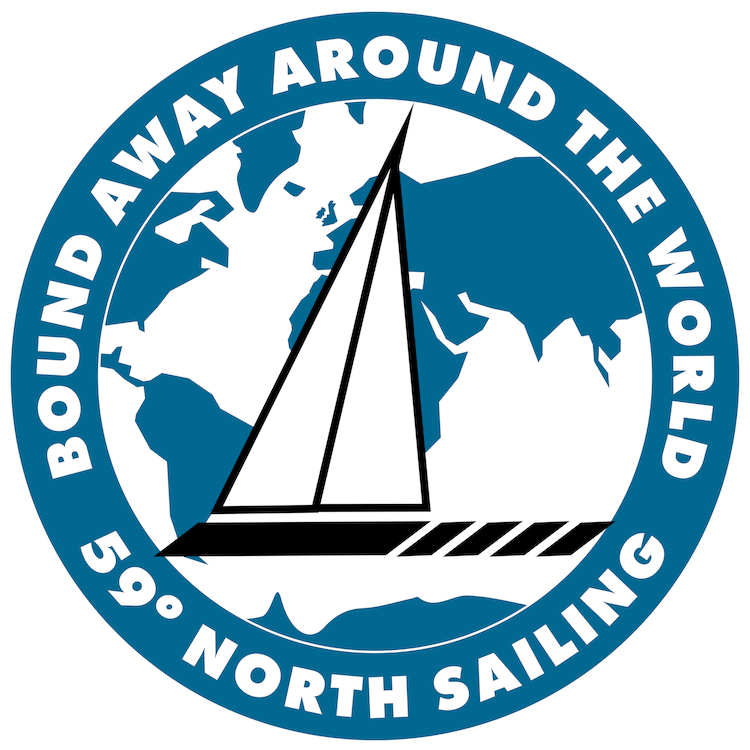Well that was the right decision. Sitting out Friday in Louisboug seemed such a tough call while we were still at sea. When I wrote that last blog post about our diversion, the weather was perfect - Isbjorn was broad reaching in 15-20 knots of wind from the SW and a gentle swell lifted the boat as it glided past.
Well that was the right decision. Sitting out Friday in Louisboug seemed such a tough call while we were still at sea. When I wrote that last blog post about our diversion, the weather was perfect - Isbjorn was broad reaching in 15-20 knots of wind from the SW and a gentle swell lifted the boat as it glided past. The sky was clear, no fog around. But those ominous clouds remained up high, and shortly after I'd sent that email, things started changing.
Every half-hour it seemed the wind increased a little more. We had tucked two reefs into the main much earlier, anticipating the increase, but with 20 miles still to go to Louisbourg we had to shorten sail some more. Isbjorn charged ahead with a few rolls in the genoa, averaging well over 8 knots and breaking double-digits on a few occasions. The Watt & Sea hydrogenerator was humming! We topped out at net +30 amps in the faster surges.
The seas built surprisingly quickly as the fog rolled in and the stronger breeze had the swell quickly cresting on the top foot or so, with whitecaps all around. We were still on the continental shelf, so the relatively shallow water made the waves steeper still. It was still relatively small - 4-6 feet - but you could tell it was on the rise. We were only four miles out from Lighthouse Point that marked the harbor entrance before we caught a glimpse of land, and by then the apparent gusts coming off the port quarter were peaking at over 30. It's not always a great idea to try and make landfall in heavy weather to an unfamiliar port, but the entrance was wide and clear and with the wind angle we could sail right in to shelter. About as easy as it gets on paper.
Once inside the first small island and into flatter water we furled the jib and motor sailed the last few hundred yards into the harbor. The fog had lifted and the sun was out but the wind was honking! The harbor was laid out SW-NE, with the town situated in the NE end, on the northern shore, and the anchorage there offered no shelter. We idled into the wind just inside the harbor entrance and I got on the VHF to ask any station for local knowledge. The Canadian coast guard maintains a station and SAR boat at Louisbourg. They came online and said our best bet was to motor to the SW corner and tuck in behind the enormous Fort Louisbourg, really an entire village itself within the walled structure. There was a two-foot chop even in the harbor, and with all sails furled we only managed 3.5 knots under power upwind towards the fort. We anchored just off the stony beach by the big yellow Frederick Gate, erected in the early 1700's as the seaward entrance to the fort. Tucked in beh
ind the fort, the wind dropped into the 20's and the harbor was calm.
The forecast offshore kept getting more and more grim, with gale warnings eventually issued for the south coast of Newfoundland and gusts off the east coast north of Cape Race into the 40s. It rained heavily on Friday for most of the morning. By then I wondered why I'd ever thought twice about seeking shelter.
We spent the whole day on the boat on anchor. Marianne made crepes for breakfast, which we ate with maple butter her and James had gotten earlier. Then we had a several-hours-long session of Marlinspike seamanship, teaching the crew how to splice and whip line. Marianne had a special affinity for splicing dyneema and ended up making six or seven dyneema loupes, which will be a handy addition to the rigging kit!
We woke early this morning and were underway by 0500. This far north it starts getting light by 0400. We were completely socked-in with fog, the fort barely visible in the dim morning light and condensation raining from the rigging. We set the mainsail, with two reefs still tied in, and navigated blindly back out through the entrance (as a note, we had the night before plotted the courses out of the harbor, making notes on a sticky pad at the nav table, including true headings, distance between turning marks and adjusted compass courses to steer. Having these notes handy for the navigator makes this kind of mission that much safer & easier, with less chance for errors in the moment). As we sailed out past Lighthouse Point again (this time never actually seeing it), we noted that the actual visibility as we passed each mark was only about 1/10th of a mile. The bell of the last green channel buoy donged as we sailed close by it. We never saw it.
As I write, we're under full sail and bang on course for Cape Race. We shook the reefs from the main as soon as we got offshore. The wind was down to a more reasonable 15-20, still SW, but there's still a big annoying swell leftover that now doesn't match the wind speed. Just in the last five minutes the wind is down even more and the rolling aboard is more uncomfortable with less wind in the sails to stabilize the boat. But it's dry outside, the sun is shining, and the fog has burned off enough to give us maybe 1/2 a mile of vis. The weather today is about as good as it can be in this part of the world. Next stop: St. John's.



